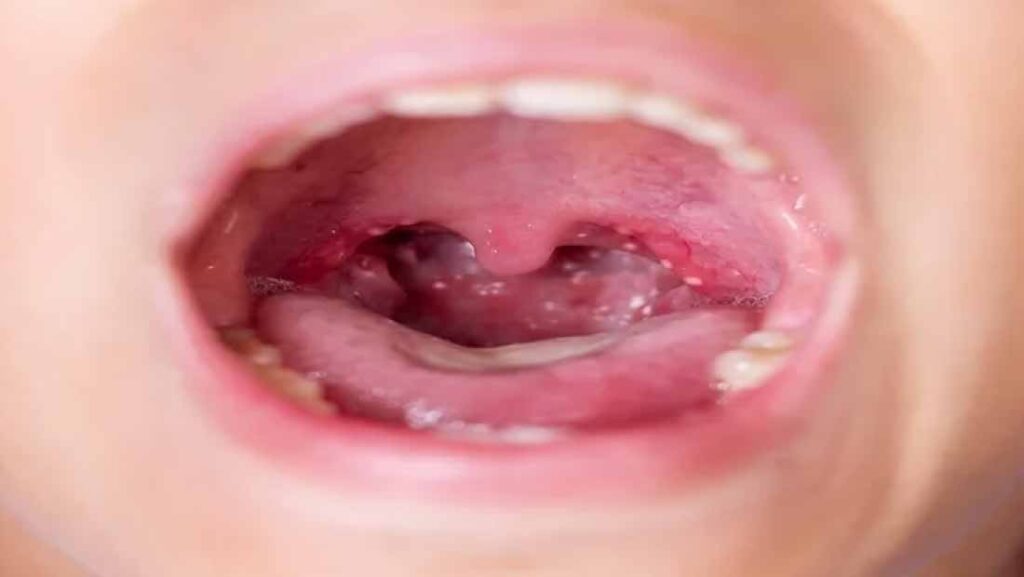Coxsackie group A
Herpangina is a viral infection characterized by acute febrile illness accompanied by ulcerative or vesicular lesions in the posterior oropharynx. The disease mainly affects children, but has been reported in newborns, adolescents, and young adults. It is highly contagious and most cases occur in the summer months. It may be associated with other diseases, such as enteroviral rash or neurological conditions.
The main symptoms of this infection include red spots on the tonsils, uvula and soft palate, which turn into a shallow ulcer. These lesions are caused by Coxsackievirus CA16 or another serotype of the virus. It is contagious and can be transmitted to children and adults through oral and fecal contamination of surfaces. The illness usually lasts three to six days and is not life-threatening.
Herpangina is a highly contagious viral infection that is usually caused by group A Coxsackie virus. This disease is usually accompanied by fever and sore throat. In some cases, it can cause ulcers, ranging in size from two to four mm in diameter. It can also result in headache, anorexia, and pain in the neck and abdomen.
Herpangina is most common in young children, but it can affect all ages. It is especially common in child care settings. Infection rates tend to peak in early summer and early fall in temperate climates, but can occur year-round in tropical areas. Herpangina is also infectious to adults, although the duration of the disease depends on the severity of the disease and the person’s level of immunity.
Coxsackie group B
Herpangina is a common viral infection characterized by acute febrile illness with small ulcerative lesions of the oropharynx. Herpangina is highly contagious and usually affects children, although it can affect people of any age. It is particularly contagious in infants and young children, as they do not have antibodies to protect against the virus.
This infectious disease is caused by a group of viruses called coxsackie, which includes group A and group B. However, there are other viruses that can cause herpangina, such as echovirus and enterovirus 71. Children usually get herpangina during the summer and fall months, and it can also affect newborns and pregnant women. While herpangina is a common disease among children, it can be serious in immunocompromised people.
There are several tests to diagnose the infection. One of these tests is the serum microneutralization assay . This test measures the level of antibodies against six Coxsackie virus serotypes. The results of this test are very sensitive and can detect chronic infections in MS patients. Antibody titer increases more than fourfold in MS patients. Another method is a complement fixation test. However, this test is not as sensitive as the serum microneutralization assay .
Coxsackie viruses are common pathogens that cause various diseases. Group B causes myocarditis, aseptic meningitis, and epidemic pleurodynia. Group A causes herpangina. Infections with this virus can affect both adults and children. The virus usually has an incubation period of two to six days.
Enterovirus 71
Enterovirus 71 is a type of virus that causes herpangina, which is characterized by small ulcers and blisters on the roof of the mouth and throat. This viral infection is highly contagious and is common among young children and infants. Adults are usually less likely to develop herpangina because they have antibodies to the virus.
This virus spreads through fecal matter that is sprayed or dropped onto surfaces. It can also be spread from person to person through sneezing or aerosols. Because the virus can be shed in the stool for weeks after infection, it is important to keep your skin and hands clean. Infected children should avoid scratching or piercing blistered lesions as they contain fecal matter.
Diagnosis is usually based on clinical symptoms and medical history. In mild cases, laboratory studies are not necessary. However, when a patient has severe herpangina, laboratory studies may be needed to rule out other conditions. The white blood cell count will usually be within normal ranges, although in some cases lymphocytosis may be present. In most cases, antibiotics are not needed. Treatment for herpangina focuses on relieving symptoms and relieving pain. Treatment usually resolves the symptoms of herpangina within a week or two.
Herpangina is primarily a pediatric disease and can be very distressing for the child and family. Therefore, it is important to teach children and their parents about their contagiousness and avoid contact with others while they are sick. It’s also important to closely monitor your child’s symptoms and make sure handwashing is appropriate.
Virus echovirus and herpangina
A viral infection known as herpangina is a common cause of painful ulcers in the mouth and throat. Symptoms of herpangina usually occur in young children, but can affect adults. It causes sores and ulcers in the back of the throat and palate. This condition usually spreads during the summer months and is caused by a type of enterovirus known as Coxsackievirus A.
A doctor can diagnose herpangina by looking at the patient’s symptoms and medical history. In mild cases, no lab tests or imaging are needed. However, laboratory studies are done if complications develop. The white blood cell count is usually normal, although some patients may have lymphocytosis. Confirmatory testing is only necessary in the presence of a severe infection or to collect epidemiological data during epidemics. However, this test can take up to a week to produce results and is not practical in clinical practice.
Most echovirus infections are asymptomatic, but some cases are associated with severe illness. Unlike most other enteroviruses, echovirus is not directly associated with any particular disease. Different echovirus serotypes cause similar clinical illnesses and different people may experience different symptoms during an epidemic.
While this infection is usually asymptomatic, it can be life-threatening. In addition to herpangina, it can cause neonatal hepatitis. The infection is usually transmitted through close contact between infected nurses and infants. Babies who have been in an intensive care ward for more than two days are at a higher risk of infection. In addition, being a twin can also increase the risk of infection.
Coxsackie A16 and Herpangina
Coxsackievirus group A (CxsA16) is the etiologic agent of hand-foot-mouth disease. It has an incubation period of 4 to 6 days. Symptoms include fever, anorexia and sore throat. Lesions erupt on the hands and feet and can also occur on the face or arms.
Herpangina is a viral infection most often caused by group A coxsackie virus, although it can be caused by group B coxsackie virus, echovirus, or enterovirus 71. It mainly affects children, but is known to occur in pregnant women and newborns. It is highly contagious and can be fatal, but most cases are mild and resolve on their own.
Symptoms of herpangina include red spots on the soft palate and tonsils, which turn into small blisters. These blisters may eventually form small yellow ulcers with a red border. Ulcers are typically 1-2 mm in diameter and one to two in number. Tend to develop in the back of the throat, tonsils, or soft palate. Ulcers usually heal on their own within five to 10 days, once the fever has subsided.
Coxsackie A16 infection and herpangia is highly contagious. Most cases do not require lab tests or imaging. Laboratory studies are only necessary if there are complications or to rule out other diagnoses. The white blood cell count is usually normal, but in rare cases lymphocytosis may occur. The infection is usually self-limiting and treatment is supportive. There is no need for antibiotics for herpangina.
Coxsackie B1-5 and Herpangina
Coxsackie virus is a group of six enteroviruses that can cause gastrointestinal upset, aseptic meningitis, pericarditis, and myocarditis in humans. In the past, Coxsackie virus infections were not thought to be fatal. Recently, however, five reports of infant deaths from Coxsackie virus infections have been published. Four of these reports came from South Africa and the other two from the United States.
Serum samples were passed through two cell lines, the RD cell line and the MRC5 cell line, to examine viral cytopathic effects. Indirect immunological testing was also performed to detect antibodies against early adenovirus antigen and cytomegalovirus and Argene. After passing the samples through the cell lines, they were stored at -20°C for further study.
The disease is highly contagious and symptoms begin 3 to 5 days after exposure. It is contagious for the first two weeks after infection and is most contagious in children. Adults can also get herpangina, but they may not develop symptoms until later in life. The duration of illness will vary depending on the severity of the infection. Children frequently touch various surfaces and do not practice optimal personal hygiene, so prevention is essential. To prevent the spread of the virus, children should wash their hands thoroughly and disinfect doorknobs and toys.
Several complications of herpangina include dehydration. Signs of dehydration include decreased skin turgor and dry mouth.


